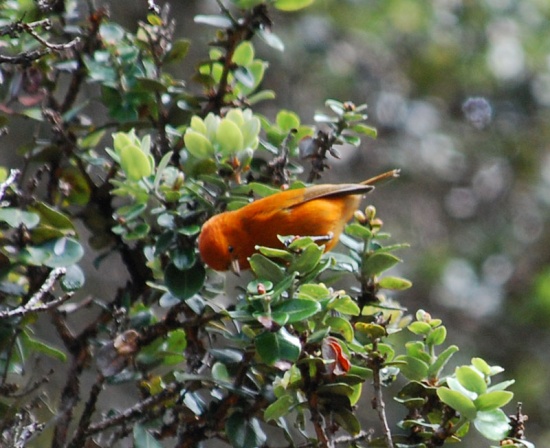(User template added to Photo) |
(Pictures of female & poss Juvenile Male. Taxonomy amended. Referenced) |
||
| Line 1: | Line 1: | ||
| − | [[Image:Male_'Akepa.jpg|thumb|550px|right|Photo by {{user|bkrownd|bkrownd}} <br/> | + | [[Image:Male_'Akepa.jpg|thumb|550px|right|Photo by {{user|bkrownd|bkrownd}} <br /> Hakalau Forest NWR, [[Hawaii]] Island.]] |
;[[:Category:Loxops|Loxops]] coccineus | ;[[:Category:Loxops|Loxops]] coccineus | ||
==Identification== | ==Identification== | ||
| − | Adult males are a bright orange. | + | Adult '''males''' are a bright orange.<br /> |
| − | + | '''Females''' and '''juvenile''' males are grey and green, with an orange breast. | |
==Distribution== | ==Distribution== | ||
| − | [[Hawaii]]. 'Akepa are most greatly concentrated in the Pua 'Akala tract of Hakalau National Wildlife Refuge on the windward slope of Mauna Kea, and along the upper edge of the Ka'u forest reserve on the South slope of Mauna Loa. Reforestation efforts in the Keauhou Ranch and Kulani Correctional Facility properties on the upper windward slope of Mauna Loa will improve another important population center. They can occasionally be observed just North of this area in large kipukas on the Mauna Loa-Mauna Kea saddle, along Powerline Road | + | [[Hawaii]]. 'Akepa are most greatly concentrated in the Pua 'Akala tract of Hakalau National Wildlife Refuge on the windward slope of Mauna Kea, and along the upper edge of the Ka'u forest reserve on the South slope of Mauna Loa. Reforestation efforts in the Keauhou Ranch and Kulani Correctional Facility properties on the upper windward slope of Mauna Loa will improve another important population center. They can occasionally be observed just North of this area in large kipukas on the Mauna Loa-Mauna Kea saddle, along Powerline Road. |
| + | Small pockets of 'akepa persisted until recent decades in central Kona on the leeward slope of Mauna Loa, and on the North slope of Hualalai. | ||
| + | [[Image:44104P1140492 sharp.jpg|thumb|350px|right|Female<br />Photo by {{user|bkrownd|bkrownd}}<br />3 mile kipuka, Powerline Road, Eastern Saddle, [[Hawaii]], January 2007]] | ||
==Taxonomy== | ==Taxonomy== | ||
| − | + | ====Subspecies<sup>[[#References|[1]]]</sup>==== | |
| + | *''L. c. coccineus'': | ||
| + | :*Montane ohia and koa forests of [[Hawaii]] | ||
| + | *''L. c. wolstenholmei'': | ||
| + | :*Formerly montane ohia and koa forests on Oahu. Extinct ca 1900 | ||
| + | *''L. c. ochraceus '': | ||
| + | :*Montane ohia and koa forests of Maui. Probably extinct | ||
==Habitat== | ==Habitat== | ||
The 'akepa gleans insects from the outer leaves of branches near the crowns of 'ohi'a trees, using the crossed tips of its bill to open budding leaves. | The 'akepa gleans insects from the outer leaves of branches near the crowns of 'ohi'a trees, using the crossed tips of its bill to open budding leaves. | ||
| − | + | [[Image:DSC 17091 800sh.jpg|thumb|350px|right|Juvenile Male?<br /> Photo by {{user|bkrownd|bkrownd}}<br />3 mile Kipuka, Powerline Road, Mauna Loa kipuka mosaic, [[Hawaii]], May 2008 ]] | |
==Behaviour== | ==Behaviour== | ||
They prefer to live near large old 'ohi'a trees that have natural nesting cavities. | They prefer to live near large old 'ohi'a trees that have natural nesting cavities. | ||
| − | |||
====Vocalisation==== | ====Vocalisation==== | ||
'Akepa have a high weak voice. The male's song is a short weak descending trill, of variable tempo which often slows midway through. Juvenile begging calls are a persistent soft ''wit-wit wit-wit wi-wi-wit''. | 'Akepa have a high weak voice. The male's song is a short weak descending trill, of variable tempo which often slows midway through. Juvenile begging calls are a persistent soft ''wit-wit wit-wit wi-wi-wit''. | ||
| − | + | ==References== | |
| + | #{{Ref-Clements6thDec08}} | ||
| + | {{ref}} | ||
==External Links== | ==External Links== | ||
{{GSearch|Loxops+coccineus}} | {{GSearch|Loxops+coccineus}} | ||
[[Category:Birds]][[Category:Loxops]] | [[Category:Birds]][[Category:Loxops]] | ||
Revision as of 21:21, 10 June 2009
- Loxops coccineus
Identification
Adult males are a bright orange.
Females and juvenile males are grey and green, with an orange breast.
Distribution
Hawaii. 'Akepa are most greatly concentrated in the Pua 'Akala tract of Hakalau National Wildlife Refuge on the windward slope of Mauna Kea, and along the upper edge of the Ka'u forest reserve on the South slope of Mauna Loa. Reforestation efforts in the Keauhou Ranch and Kulani Correctional Facility properties on the upper windward slope of Mauna Loa will improve another important population center. They can occasionally be observed just North of this area in large kipukas on the Mauna Loa-Mauna Kea saddle, along Powerline Road.
Small pockets of 'akepa persisted until recent decades in central Kona on the leeward slope of Mauna Loa, and on the North slope of Hualalai.
Taxonomy
Subspecies[1]
- L. c. coccineus:
- Montane ohia and koa forests of Hawaii
- L. c. wolstenholmei:
- Formerly montane ohia and koa forests on Oahu. Extinct ca 1900
- L. c. ochraceus :
- Montane ohia and koa forests of Maui. Probably extinct
Habitat
The 'akepa gleans insects from the outer leaves of branches near the crowns of 'ohi'a trees, using the crossed tips of its bill to open budding leaves.
Behaviour
They prefer to live near large old 'ohi'a trees that have natural nesting cavities.
Vocalisation
'Akepa have a high weak voice. The male's song is a short weak descending trill, of variable tempo which often slows midway through. Juvenile begging calls are a persistent soft wit-wit wit-wit wi-wi-wit.
References
- Clements, JF. 2008. The Clements Checklist of Birds of the World. 6th ed., with updates to December 2008. Ithaca: Cornell Univ. Press. ISBN 978-0801445019.
Recommended Citation
- BirdForum Opus contributors. (2024) Akepa. In: BirdForum, the forum for wild birds and birding. Retrieved 17 June 2024 from https://www.birdforum.net/opus/Akepa






